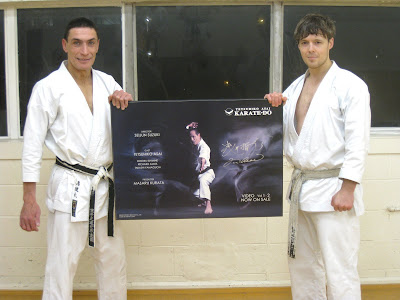I decided to title this post "Talking with one's karate". Why? Because this outlines my philosophy, and is turned into a reality daily, via predetermined practices (which I engineer in an effort to avoid mediocrity). I hope this finds you well and training hard!
________
AUGUST TRAINING REGIME
________
Sonoba-Kihon: (a) Migi chudan gyaku zuki;
(b) Hidari chudan gyaku zuki;
(c) Migi mae jodan hiza geri;
(d) Hidari mae jodan hiza geri;
(e) Migi chudan mae geri kara migi jodan mae geri soshite hidari jodan mae kekomi;
(f) Hidari chudan mae geri kara hidari jodan ma e geri soshite migi jodan mae kekomi
e geri soshite migi jodan mae kekomi. {30-50 repetitions of each}.
_________
Ido-Kihon: (1) Chudan oi zuki; (2) Jodan age uke karate chudan gyaku zuki; (3) Chudan soto uke kara chudan gyaku zuki; (4) Chudan shuto uke kara shihon nukite; (5) Chudan uchi uke kara chudan gyaku zuki; (6) Tenshin gyaku zuki (7) Jodan mae geri; (8) Jodan mawashi geri; (9) Jodan ushiro geri; (10) Jodan yoko keage; (11) Jodan yoko kekomi; (12) Henka-waza involving several variations of shuto uchi & kaiten uraken uchi. {Only 10-30 repetitions of each}.
________
Key focal points within my current kihon practice include: 1.0/ Correct and optimal use of the jiku-ashi; 1.1/ The "shisei-unsoku connection"; 1.2/ Legs first, hips second & limb third; & 1.3/ Target penetration (applied in my corresponding daily makiwara training).
_________

Kata: Keeping in mind the previously mentioned focal points, my kata practice at present strongly reflect these, but with a more direct `flow' into kumite (especially in regards to smooth and effective transitions). To achieve these comprehensive refinements I've employed the following kata in my routine: Heian-shodan, Heian-nidan and Heian-sandan, Junro-shodan, Jion, Empi & Shinobiyoru-hayabusa. I am also blasting out Fudoken-sho and Gojushiho-dai purely to shock my body. {Typically I do each kata three times each or just one, or two of the kata, multiple times in succession}.
________
Kumite: I've been stressing correct
shisei in my attacks and
counterattacks. In fundamental terms this effectively permits a properly connected/co-ordinated
johanshin and
kahanshin to get the business done. To achieve these targets I've been using

limited
jiyu-
kumite and a relatively varied mix of
yakusoku-
kumite drills.
______
OSU, André.
______
© André Bertel, New Zealand 2010.
 Paul Kallender has just published a new article on his excellent karate blog which is focusing on fundamental koshi no kaiten (hip rotation). It really was a pleasure for me to contribute to this article, however the real treasures are from Paul's quotes from recent training with Sakae Ibusuki Sensei.
Paul Kallender has just published a new article on his excellent karate blog which is focusing on fundamental koshi no kaiten (hip rotation). It really was a pleasure for me to contribute to this article, however the real treasures are from Paul's quotes from recent training with Sakae Ibusuki Sensei. 






 Rather than giving my own definition of karate-do I thought it would be most appropriate quote Nakayama Sensei. But before I do so, I’ll explain why, by extracting a section from an article I wrote for my dojo newsletter in 1993.
Rather than giving my own definition of karate-do I thought it would be most appropriate quote Nakayama Sensei. But before I do so, I’ll explain why, by extracting a section from an article I wrote for my dojo newsletter in 1993.